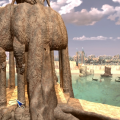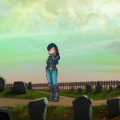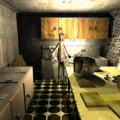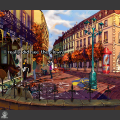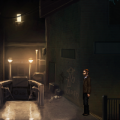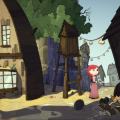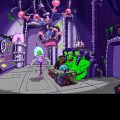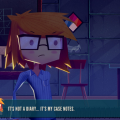
American cover
House of Tales’ Overclocked: A History of Violence can best be described as a game that came out before developers caught on to the approach that would have best suited it. It’s an interactive drama dressed up like a point-and-click adventure game that was released ever so slightly before interactive dramas took off in mainstream gaming.
Back in 2008, Quantum Dream’s Indigo Prophecy (2005) was still considered a one-off oddity – the company was two years off from releasing Heavy Rain – Telltale Games was still making puzzle adventure games like the Sam & Max reboot series, and Dontnod had only just formed without a release to its name, years away from Life is Strange. The idea of an “interactive drama” in the modern sense hadn’t yet taken root. The 90s were replete with FMV games that were more movie than game, sure, but the QTE-heavy, choice-based formula wasn’t as central as it would become in the 2010s.
Which is a shame because Overclocked – an adventure game with almost no puzzles but a lot of cinematic ambition – could have made a great game if it had gone the route that brought later developers acclaim.

The game concerns a psychiatrist and army veteran named David McNamara, who travels to New York City in the middle of a heavy downpour to treat five traumatized teen patients at a psychiatric facility on Staten Island. The teens suddenly appeared in the city carrying guns and acting agitated. They remember nothing, not even their names or how they got there. McNamara is chosen to interview these kids because he developed a special therapy for memory recovery. He uses this technique to put together what happened to the teens.
All the while, McNamara’s life is falling apart. He faces hostility from the Staten Island facility’s staff, estrangement from his wife, signs of a sinister conspiracy at the root of this investigation, and long-festering anger issues from within himself.
The game is told in five chapters. The first two chapters are somewhat longer than the last three, giving the pacing a lopsided feel. Each moves according to the same general pattern: McNamara wakes up in his hotel, takes the ferry to Staten Island, interviews his patients at the hospital, takes the ferry back, goes to the bar, and returns to the hotel for the night. Something odd usually happens while you’re waiting for the ferry, and McNamara usually has some personal crisis pop up when he returns to the hotel for the night.

You won’t be solving many puzzles as McNamara. For the most part, all he does is talk to people. You spend the bulk of the McNamara’s portion of the game running back and forth between patients trying to figure out who is going to have a memory breakthrough and tell you the next part of the story. This is achieved by playing a recording of each patient’s recollections, which can trigger further memories. Choosing which recording to play is supposed to be a puzzle, but feels like arbitrary guesswork more than anything.
The core of the challenge comes through in the flashback sequences. Although some are merely non-interactive scenes, most involve light puzzle solving. Emphasis on the “light.” Clicking on one item then clicking on another kind of light. Few puzzles will give even a casual adventure gamer much grief – a lot of finding keys, unlocking grates, restoring power to lights and radios, that kind of thing. The player won’t have to suffer through pixel hunting since the developers put in a hotspot highlight function in. There’s one instance where you shoot down a tower of bricks with a handgun, which shows the developers incorporated some shooting mechanics into the engine. But it’s never used again.
Martin Ganteföhr, one of the co-founders of House of Tales along with Tobias Schachte, explains the lack of puzzles in Overclocked by describing his broad view of interactivity. He argues that “thinking about something” is itself a form of interactivity.
“Figuring out stories and characters can be very challenging, and it can feel interactive, even with less (or simpler) actual game manipulation involved,” he said in an interview with Adventure Classic Gaming. “… To me, giving the player something to think about means giving them something to do.”

Although an interesting idea in theory, and one that interactive drama developers would take advantage of in the years to come – plus visual novel developers have been doing this from the start – the story isn’t strong enough to hold up this view. It simply doesn’t give the player enough to think about. Regardless of intent, the way the game is structured and the framework of the engine gives the expectation of some interactivity beyond wading through dialogue.
Overclocked makes use of split screens and shifting camera angles for dramatic effect, which gives the visuals a distinct edge to them – a welcome addition since the 3D models and backgrounds are otherwise nothing much to speak of. Not to say they’re ugly though. There was clearly a lot of work put into making expressive and dynamic faces for character models, which is nice, but they still don’t look great. The rain-swept atmosphere, however, is very strong and adds a lot to overall experience. The exterior backgrounds are really gorgeous, though the interiors can be stale.
The game, as the subtitle indicates, is about violence and the psychological origins of aggression. In as vague a way as it can be put without spoiling, eventually McNamara finds out the teens took part of some kind of rage-inducing experiment.

Ganteföhr said that he chose the topic of violence because it interested him personally.
“[M]aking games is a very personal process for me,” Ganteföhr said in the same interview quoted above. “I have many questions about life, and as long as somebody is willing to listen, I will try to convey my thoughts and feelings in my games.”
The story seems to want to reveal something about the nature of violence in videogames, or the military’s influence on videogame culture, or the violence all people may or may not harbor within themselves, but the themes rarely ever amount to anything. McNamara’s descent into instability is handled well – at least as well as it can through awkward dialogue and clumsy voice acting – but the story flounders in its flashbacks, retreading through the same events from different angles, unsure where it wants to go.
Despite these flaws – not to mention the basic adventure gaming faux pas of slow and unskippable dialogue – there is something appealing about Overclocked. Its moody atmosphere is infectious. It feels like it’s made by a group of people who are enthusiastic about the premise. It’s slow and awkward and despite its ambitions it ends up having all the thematic heft of a run-of-the-mill TV crime drama. But the way it bridges traditional point-and-click adventure design with a more “interactive drama” approach to storytelling makes it an interesting footnote in adventure gaming history. It’s worth your time if you’re interested in that kind of thing.

House of Tales used an engine developed in-house for all of its games called Inca, or “Interactive Narrator’s Companion for Authoring.” According to an article in a German adventure gaming website, Inca is half a graphical user interface for the “creation of rooms and characters, the import of graphics, sounds and music, the scripting of dialogues and the setting of events”; and half an an adventure-specific scripting language. It was intended as a development tool to be shared among adventure game developers along the lines of Adventure Game Studio or Visionaire, but it doesn’t appear to have ever taken off with developers outside House of Tales.
House of Tales’ first game was The Mystery of the Druids in 2001, which is notorious for its ridiculous box art. Its best known game is The Moment of Silence, a dystopian investigative thriller from 2004. Otherwise, the studio created several mobile games including an X-Files tie-in called The X-Files: The Deserter.
Its penultimate game 15 Days came out in 2009. The developers must not have taken criticisms of Overclocked to heart, because 15 Days was also criticized for its low amount of interactivity – one critic observed there were only two instances of what could reasonably be called “puzzles.” Its last release was a hidden object game called The Mystery of the Ghost Ship in 2010.

Ganteföhr got the chance to helm a videogame project again in 2018 as creative lead for State of Mind, another dystopian thriller, this time focused on themes of transhumanism. It has received mostly positive reviews and got a wide release on a number of platforms. Schachte meanwhile appears to have left the industry – Ghost Ship was his last developer credit.
House of Tales’ history intertwines with that of Cranberry Production, the creators of The Black Mirror 2 and 3. Like Cranberry, House of Tales was bought by DTP Entertainment in 2008. It was allowed to remain an independent studio up until 15 Days’ poor sales led to a conflict with DTP. As a result, Schachte left the company in January 2010, then Ganteföhr left in March the same year.
House of Tales’ company headquarters was moved from Bremen to Hannover, Germany, where Cranberry was based. The remaining House of Tales team was integrated into the Cranberry team, ending the company.
In December 2014, as with many small adventure game studios, the Swedish publisher THQ Nordic acquired the rights to House of Tales’ games and started selling them on digital distribution sites like Good Old Games and Steam.
